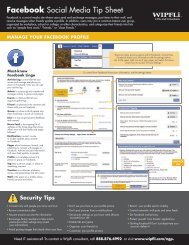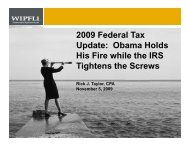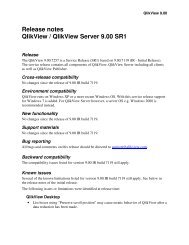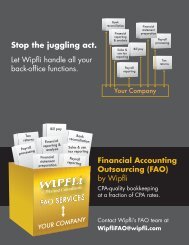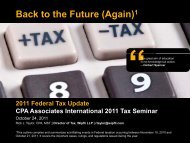Download PDF - Wipfli
Download PDF - Wipfli
Download PDF - Wipfli
You also want an ePaper? Increase the reach of your titles
YUMPU automatically turns print PDFs into web optimized ePapers that Google loves.
USA Update continued<br />
of any asset, but the taxpayer fails to provide sufficient<br />
information for the IRS to determine the value, the taxpayer<br />
is presumed to own specified foreign assets with a value of<br />
more than the applicable reporting threshold.<br />
Draft Form 8938 and instructions can be obtained from the<br />
following links<br />
http://www.irs.gov/pub/irs-dft/f8938--dft.pdf<br />
http://www.irs.gov/pub/irs-dft/i8938--dft.pdf<br />
For more information please contact:<br />
Leo Parmegiani, CPA<br />
Tax Partner in Charge<br />
PKF LLP<br />
Certified Public Accountants<br />
T: +1 (212) 867-8000 x 426<br />
F: +1 (212) 687-4346<br />
E: LParmegiani@PKFNY.COM<br />
W: www.pkfnewyork.com<br />
IRS Announces 2011 Voluntary<br />
Compliance Program Focused<br />
on Employee vs. Independent<br />
Contractor Exposure<br />
On 21 September 2011, the Internal Revenue Service (IRS)<br />
unveiled a Voluntary Compliance Program (VCP) that offers<br />
relief for businesses which may have misclassified workers<br />
as independent contractors, rather than employees, and so<br />
are potentially liable for significant additional taxes, penalties,<br />
and interest.<br />
Background<br />
Prior to announcement of the VCP, the IRS and the<br />
Department of Labor (DOL)stepped up joint enforcement<br />
efforts by signing a new memorandum of understanding to<br />
strengthen information sharing on enforcement actions aimed<br />
at misclassified workers. Several states are parties to the<br />
agreement including, inter alia, New York and Connecticut.<br />
Observation: This enforcement issue has become more urgent<br />
as both federal and state authorities seek additional tax<br />
revenues to close large current and projected budget deficits.<br />
VCP Summary<br />
The VCP is available for employers which are currently treating<br />
(perhaps incorrectly) workers or a class of workers as<br />
independent contractors, but want to prospectively reclassify<br />
the workers as employees for federal employment tax<br />
purposes. The IRS retains discretion over whether to accept<br />
an employer into the VCP.<br />
VCP Consequences<br />
Under the VCP, eligible taxpayers will generally be entitled<br />
to settle their employment tax liability under a single-year<br />
assessment of employment taxes of 10% of the Internal<br />
Revenue Code Section 3509 rates applicable to the most<br />
recently closed tax year. A 10.68% effective rate applies<br />
under the VCP in 2011, since the most recently closed tax<br />
year is 2010, and a 10.28% effective rate will apply in 2012.<br />
A rate of 3.24% also applies to compensation above the<br />
Social Security wage base in both years. These rates<br />
include federal income tax withholding and employer/<br />
employee social security and medicare tax.<br />
Observation: Employers in the program will generally pay<br />
an amount equal to just over 1% of the wages paid to<br />
reclassified workers for the most recent tax year and will<br />
eliminate the potential exposure for all prior years. It is<br />
unclear how states will react to the VCP program.<br />
VCP Qualifications<br />
The VCP is open to businesses, including exempt<br />
organisations, which have treated workers as independent<br />
contractors in the past, have filed Forms 1099 for the<br />
previous three years, and are not currently under a worker<br />
classification audit by the IRS, the DOL, or a state agency.<br />
An employer previously audited by the IRS or DOL<br />
concerning worker classification is eligible for this Program<br />
if it has complied with the results of such an audit.<br />
Under the Program, an employer does not have to reclassify<br />
all of its workers who are currently treated as non-employees.<br />
However, once an employer chooses to reclassify certain of<br />
its workers as employees, all workers in the same class –<br />
i.e., workers who perform the same or similar services –<br />
must be reclassified as employees.<br />
50 // PKF International Tax Alert All Regions<br />
Issue 8 November 2011






